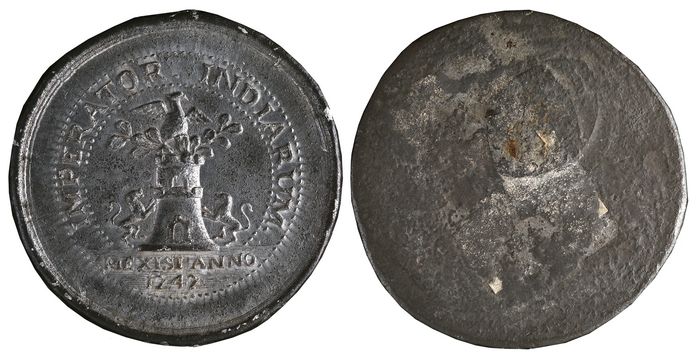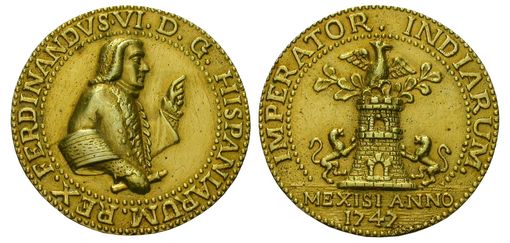A Trial Strike for Mexico’s Ferdinand VI Proclamation Medal
by Carlos Jara

A most exciting discovery piece was shown to the author at the NYINC 2016 show. It is a trial strike in pewter or lead of the reverse of the rare Ferdinand VI proclamation medal issued in Mexico in 1747 (Grove F6-3).
Perhaps three examples of that medal are known in silver, with a single specimen in gold also noted, pictured below.
 All of these medals are cast, as are in fact all proclamation medals issued by Mexican authorities before the ones corresponding to Charles III (1760). This seems indeed odd considering that the mint of that city was the most advanced in the Americas and as such the first to issue milled coins among the Spanish Colonial mints. By 1747 Mexico had been issuing struck milled coins for 15 years and had obviously mastered the vicissitudes related with that minting technique, yet no struck proclamation medals were issued for the new king Ferdinand VI in the ceremonies held in that year. We might in fact note that even the obviously more precarious mint of Guatemala had managed to issue struck milled proclamation medals for Ferdinand VI in that same 1747 year, although those carefully minted issues also served a more practical purpose in addition to the display of fidelity to the new kingAll evidence points to them being used as an experimental strike for the then recently completed minting press. See Carlos Jara, Historia de la Casa de Guatemala: 1731-1776, p. 81..
All of these medals are cast, as are in fact all proclamation medals issued by Mexican authorities before the ones corresponding to Charles III (1760). This seems indeed odd considering that the mint of that city was the most advanced in the Americas and as such the first to issue milled coins among the Spanish Colonial mints. By 1747 Mexico had been issuing struck milled coins for 15 years and had obviously mastered the vicissitudes related with that minting technique, yet no struck proclamation medals were issued for the new king Ferdinand VI in the ceremonies held in that year. We might in fact note that even the obviously more precarious mint of Guatemala had managed to issue struck milled proclamation medals for Ferdinand VI in that same 1747 year, although those carefully minted issues also served a more practical purpose in addition to the display of fidelity to the new kingAll evidence points to them being used as an experimental strike for the then recently completed minting press. See Carlos Jara, Historia de la Casa de Guatemala: 1731-1776, p. 81..
As will be seen, the decision to issue cast rather than strike proclamation medals in Mexico was effectively the result of many considerations, the first among which was the difficulty to produce engraved dies suitable to strike the medals in a relatively short period of time. The authorities in Mexico City must have officially acknowledged the death of previous king Philip V around the end of 1746 since the ship El Cavallo Marino from Havana (Cuba) carrying this news had arrived in Veracruz on 17 December 1746 See “Festivas Aclamaciones de Mexico en la Inauguracion al throno de el Rey nuestro señor Don Fernando Sexto (que Dios guarde)”. p. 6, part of José Mariano de Abarca, "El sol en Leon solemnes aplausos conque, el rey nuestro señor d. Fernando VI. sol de las Españas, fue celebrado el dia 11. de febrero del año de 1747 en que se proclamó Su Magestad exaltada al solio de dos mundos por la muy noble, y muy leal imperial ciudad de Mexico, quien lo dedica a la reyna n. señora da. Maria Barbara Xavier…"(more than four months after the actual death). The Viceroy issued a notification on 13 January 1747, and instructed for the date of the celebration of the corresponding ceremonies as follows:
“Having the death of the king our lord D. Philip V (may God hold him) and the days of his royal obsequies been announced, and after being instructed by H. M. (may God guard him) in his Royal Ordinance of thirty one of July of the past year to celebrate his Proclamation…. on the due day of the eleventh of the following month of February…”See “Festivas Aclamaciones de Mexico en la Inauguracion", pp.15-16..
Upon receipt of this edict, the local Council or Cabildo designated commisioners for each task of the preparations. In particular, it was decided that “the adornment of the Royal Standard and the dressing of the clarinetists and timbalists (drummers) (would be) in charge of the Mayor… the smelting of the coins that would be distributed on the day of the Proclamation (would be) in charge of the General Procurator D. Joseph de Cuevas Aguirre.”See “Festivas Aclamaciones de Mexico en la Inauguracion..”, pp. 19/footnote}
On the day of the Proclamation ceremonies, “A great number of the coins (medals) that were commissioned by this Most Noble City were dispersed among the numerous audience … Each medal weighted approximately one half ounce. Some were of gold, many of gilt silver and the most of pure silver, all bearing on one side the image of his majesty with the following (circular) inscription: FERDINANDUS SEXTUS HISPANIARUM REX. ANNO 1747. And on the other the arms of this Imperial City and the legend: IMPERATOR INDIARUM.”See “Festivas Aclamaciones de Mexico en la Inauguracion..”, pp. 72-73
The ½ ounce medals referred to in this account are evidently the Grove F6-1, similar to but smaller than Grove F6-3 which is the silver version of the unique gold medal plated herein. This aforementioned account also proves that all of these medals were produced in Mexico between 11 January and 12 February of 1747. Another fact, already pointed out by Manuel Romero de Terreros, hinting to the fact that the Ferdinand VI proclamation medals issued in Mexico must all have been commissioned locallyA contemporary account – also partially transcribed in Medina , Las Monedas Coloniales Hispano-Americanas, p.56 - exists regarding a closely related proclamation medal, also issued in the name of Ferdinand VI in 1747 but in Yucatán. It indicates that that the first step taken by the Real regarding the organization of the proclamation ceremonies was the “manufacture of a die (sic: mould) with the image of His Majesty which was so beautifully and perfectly rendered that when transferred to the coins (medals), it attracted the hearts (love) and eyes of the people in much higher ways that the silver in which (these medals were struck and) the effigy of their lord and master appeared”. is that the depictions of the king all differ between the different issues and bear no close resemblance to the real image itself: de Terreros wrote that “in conclusion, it can be asserted that the Mexican portraits of Ferdinand VI were all products of the fantasy of each artist, since none bear any resemblance to the authentic portrait of the pacific king, as depicted in the famous painting by Van Loo “La Familia de Felipe V”Manuel Romero de Terreros, Las efigies de Fernando VI en México, Mexico, 1954.
As noted previously, to produce working dies to strike the aforementioned medals in this period of 30 days was a possible but evidently difficult task that must have been ruled out early on: the quoted contemporary account states indeed that the Main Procurator would be in charge of smelting the (corresponding) coins. The same account also indicates that the similar medals commissioned by the Consulate (Grove F6-6 and F 6-6a) were issued in rather large numbers (3,000 pieces in silver and 100 in gold) thus necessitating decent quality dies if having been struck instead of cast.
The production cost of these issues was also probably a factor, since commissioning these medals to a local silversmith or platero (as they indeed were in all probability, judging from their cruder workmanship) would undoubtedly result in lower expensesfootnote} One recalls here the controversy that took place in the Guatemala mint in 1789 between then newly appointed engraver Pedro García Aguirre and mint Director Manuel de la Bodega. Aguirre demanded (and eventually was granted) the exclusive right to engrave the dies for the proclamation medals issued by that mint in that year, while de la Bodega stated that commissioning the medals to local silversmiths would result in an easier and less expensive way of manufacturing them..
A final point is the fact that the mint’s tallador (engraver) in 1747 was probably incapable of producing dies with accurate renditions of the new king’s bust from scratch (as opposed to manufacturing punches from the master dies sent from Spain): this is bluntly evident when considering the comically inaccurate bust depicted in the famous and rare one-year type “cara de perro” (dog face!) gold issues struck in 1747 from locally produced dies before the proper punches were received from Spain.
Now for a closer analysis of the discovery piece: it is undoubtedly struck from a die and matches the reverse of the gold piece also plated herein. Some differences appear nevertheless, pointing to the fact that the latter was smoothed (to remove the surface porosity from the casting) and further engraved after being cast: the depicted central tower is smooth on the trial piece yet engraved on the gold medal. It is therefore clear that at least some of the cast medals were partially re-engraved after casting.
The existence of a reverse die allows one further conclusion: the method to issue the cast medals was to strike a madre or master coin from which casting moulds would be obtained. Such a method is entirely compatible with the evidence from earlier proclamation medals of Mexico: the author is aware of the existing of such a madre for the Philip V proclamation medals.
